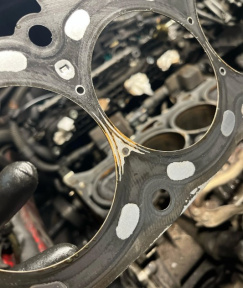
The cylinder head gasket is a component located between the cylinder head and the engine block. Its purpose is to seal off the combustion chamber as well as the cooling water and engine oil channels. The gasket must be able to withstand extremely high temperatures of well over 2,000 degrees Celsius that occur within the combustion chambers.
Symptoms of a blown head gasket

A defective cylinder head gasket manifests itself through a variety of symptoms, which are not always easy to identify:
- An uneven engine idle, which usually disappears once the engine has warmed up.
- Regular coolant loss.
- Exhaust gases in the cooling system.
- Oil leakage in the area of the cylinder head gasket.
- Engine oil in the coolant or coolant in the engine oil.
- White smoke coming from the exhaust (often particularly visible during engine startup).
In case of doubt, it is advisable to visit an automotive workshop to have the vehicle inspected for a defective cylinder head gasket. Typically, a compression test is performed during this inspection. If the compression is too low, a CO2 test is then conducted. If the CO2 test results are positive, it is highly likely that the cylinder head gasket is compromised. Waiting too long to replace it can lead to severe engine damage.
Causes of a blown head gasket

The causes of a defective cylinder head gasket are diverse. It is possible that a flaw occurred during the manufacturing or development of the engine, leading to regular overheating and damage to the gasket. However, the most common cause by far is simple driver error: high RPMs with a cold engine is a well-known method to quickly destroy the cylinder head gasket.
Overheating of the engine can also be attributed to a faulty cooling system. In other cases, poor workmanship during installation or improper mounting of the cylinder head gasket may have occurred. Additionally, vehicles with LPG conversions may have had their systems improperly installed.
Cost of replacement the blown head gasket
In general, the replacement of the cylinder head gasket should be carried out professionally by an experienced automotive mechanic. Depending on the make and model, this process may take several hours and incur costs well over $1,000. For those inclined to do it themselves (and assuming personal responsibility), there are numerous online guides available for such a DIY project.
See also:
Same articles

Understanding Vehicle Inspection and Verification Services: Why They Matter for Every Driver
GuidesVehicle inspection and verification services are an essential but often overlooked part of keeping roads safe and cars legally compliant. Most people only think about inspections when it’s...
KLIFEX Brand Overview: High-Quality Automotive Repair Kits for Affordable Repairs
GuidesThe automotive aftermarket has long needed solutions that combine reliability, durability, and affordability. Many car enthusiasts and services are looking for a way...
Fast, Reliable Vehicle Emissions & Inspection Services Made Simple
GuidesFast, reliable emissions and inspection services are essential for keeping vehicles road-ready, compliant with environmental regulations, and safe for daily driving. If you’re looking for quick...

